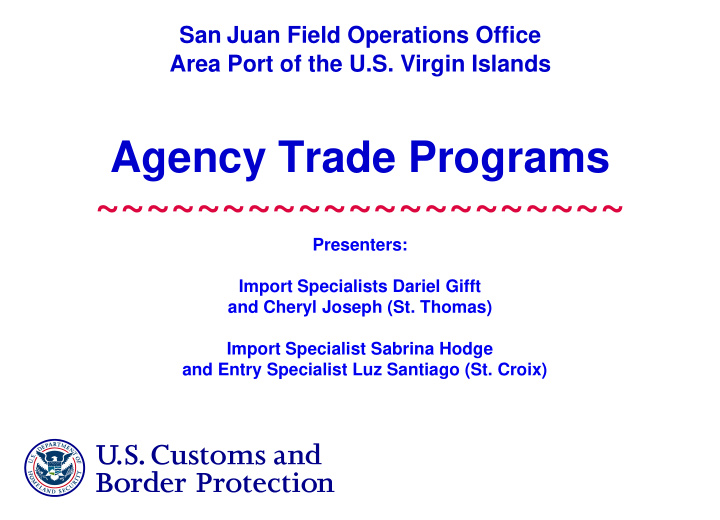



San Juan Field Operations Office Area Port of the U.S. Virgin Islands Agency Trade Programs ~~~~~~~~~~~~~~~~~~~~~ Presenters: Import Specialists Dariel Gifft and Cheryl Joseph (St. Thomas) Import Specialist Sabrina Hodge and Entry Specialist Luz Santiago (St. Croix)
BACKGROUND U.S. Customs and Border Protection in the U.S. Virgin Islands is outside the Customs Territory of the United States. CBP requirements in the U.S. Virgin Islands are unique because it operates under the Public Law 64, that was enacted in 1914, which states the maximum rate of duty is 6% on all foreign items being imported.
LEGISLATIVE ACT Act 5224, Notwithstanding any other law, raw materials and component parts (as defined by the Commission) brought into the Virgin Islands by a beneficiary for the purpose of producing, creating or assembling an article, good or commodity as a result of industrial or manufacturing processing such materials or component parts shall be imported into the Virgin Islands at a custom duty rate of one percent 1%”
ECONOMIC DEVELOPMENT AUTHORITY (EDA) CERTIFICATE BENEFICIARY Once an importer has been approved by the Economic Development Authority (EDA), the commission will forward a copy of the complete certificate to the office of the Area Port Director. Upon receipt, the certificate will be assigned a number that must be annotated on each Entry/Entry Summary the importer files claiming the EDA exemption. A notification letter, with a number assigned for Customs entry filing purposes, will be sent to the mailing address annotated on the certificate received from EDA. Certificates will not be accepted from importers. In order to receive the reduced rate of duty which is 1%, under the terms of EDA benefits, a Formal Entry Summary must file a regardless of the value of the shipment. Bonded importers have the option of using the immediate release procedure to obtain release of the merchandise. Entry/Entry Summaries must be presented to CBP according to established entry requirements.
ECONOMIC DEVELOPMENT AUTHORITY (EDA) CERTIFICATE BENEFICIARY CONTINUED Non-bonded importers must present the Entry Summary package to the Entry Control Branch in St. Croix or St. Thomas for processing prior to the release of the shipment. It is strongly recommended that you, as an EDA beneficiary, know what articles are covered by the certificate granted by EDA. Each Entry Summary submitted will be verified with the Economic Development Authority to affirm the reduced duty payable on all articles covered. If it is ascertained that articles claimed under the 1% provision are not covered, all merchandise will be dutiable at the 6% rate of duty. All questions concerning the approval of a certificate and merchandise covered by such certificates should be directed to the Virgin Islands Economic Development Authority Questions regarding the assignment of a certificate number should be directed to the Import Specialist .
GENERAL HEADNOTE 3(a)(iv), HTSUS Under General Headnote 3(a)(iv), HTSUS duty-free treatment is granted only to articles that are grown or the product of a U.S. insular possession or articles manufactured or produced there. In the case of materials imported into an insular possession, such as the U.S. Virgin Islands, they must be substantially transformed by sufficient processing into a product of the insular possession. The product that is being produced may not contain foreign materials which represent more than 70% of their value. Materials that are imported must be incorporated in the product that is being substantially transformed within an 18 month period from date of importation into the insular possession.
GENERAL HEADNOTE 3(a)(iv), HTSUS
GENERAL HEADNOTE 3(a)(iv), HTSUS Continued Importers in the U.S. Virgin Islands, who wish to participate in the duty-free certification of General Headnote 3(a)(iv), HTSUS, should submit the following information: 1. Location of business and telephone number; 2. Point of contact; 3. Type of manufacturing processing to be performed; and 4. Origin of the materials to be used 5. The location of all other work/storage locations.
GENERAL HEADNOTE 3(a)(iv), HTSUS Continued The request must be made in writing to: Area Port Director of CBP Ron de Lugo Federal Building & Courthouse 5500 Veterans Drive, Rm. 248 St. Thomas, Virgin Islands 00802 Letter will be forwarded to the Import Analysis Branch Contact will be made for an Importer’s Premise Visit at the manufacturing site for review and examination Notification of approval or disapproval will be sent in writing
TRADE AUTOMATION CBP has moved forward with automating certain commercial operations through the use of the Automated Commercial Environment (ACE) -transforming trade into a single window for processing cargo. ACE is currently being used at all other ports of entry nationally. ACE is the primary system through which the trade community reports imports and exports and the government determines admissibility. Through ACE as the Single Window, manual processes are streamlined and automated, paper is being eliminated, and the trade community is able to more easily and efficiently comply with U.S. laws and regulations. ACE offers numerous benefits for your business: Paperless process Enhanced visibility of cargo status Faster cargo release process More advanced security checks and reconciliation Streamlined submission of data elements
TRADE AUTOMATION Continued In the USVI, CBP is using ACE on a limited basis to enter and query importer records, verify importer bonds, and reference tariff numbers. The electronic submission of entry documents to CBP via ACE does not exempt trade from complying with other state/local regulations and statutes. Trade still has to meet/fulfill state or local requirements and continue with the method of document submission as designated by those government agencies. Trade partners are encouraged to visit www.cbp.gov to learn more about ACE, to include added benefits, methods for interacting with ACE, and How to Get Started. We suggest you begin with the ACEopedia which contains details on the current Automated Commercial Environment (ACE) features and their benefits, as well as details on what new features are currently being developed. The ACEopedia is updated monthly and reflects the current status of ACE functionality, benefits and process.
Questions & Answers
THANK YOU
Recommend
More recommend